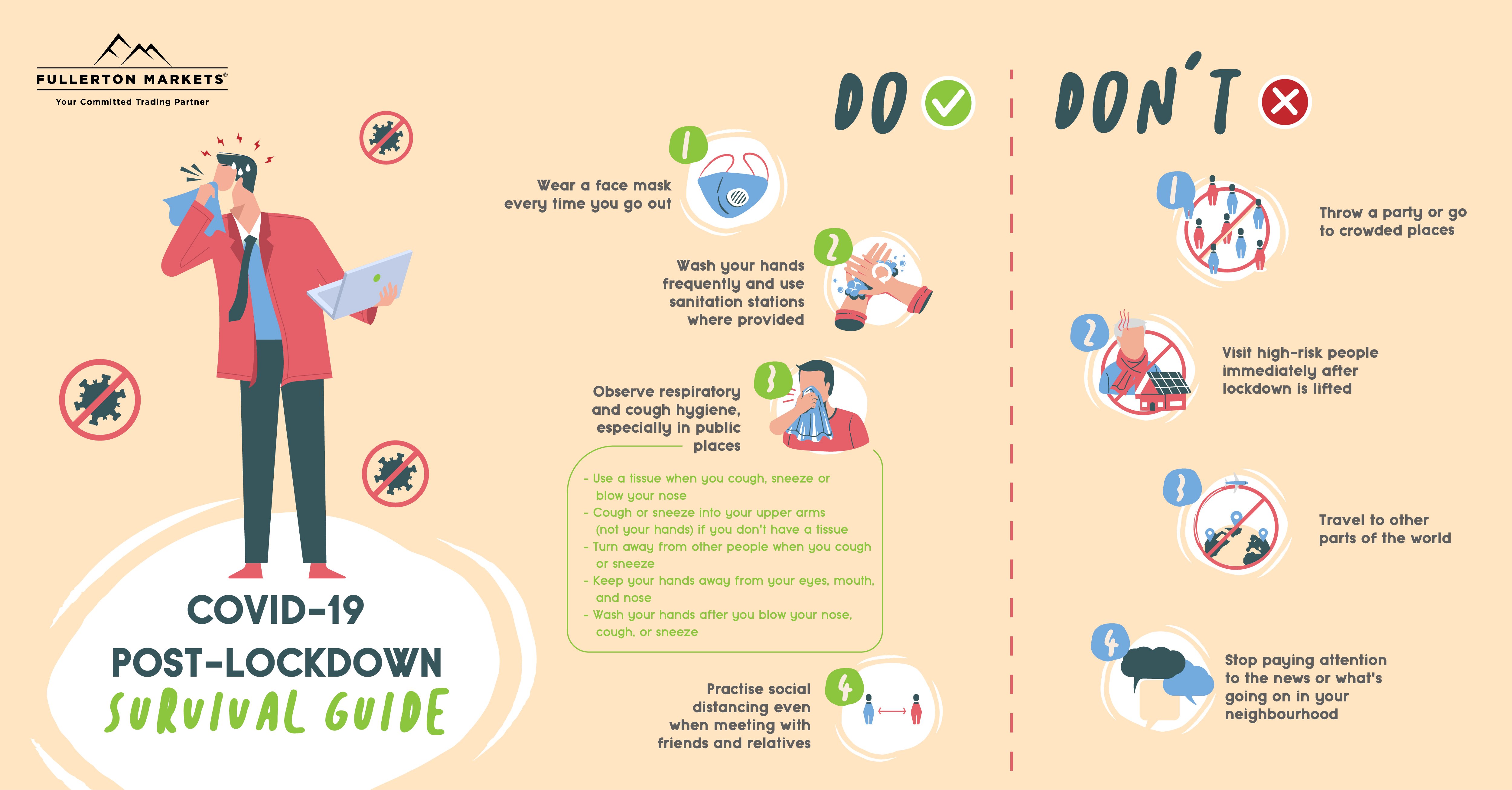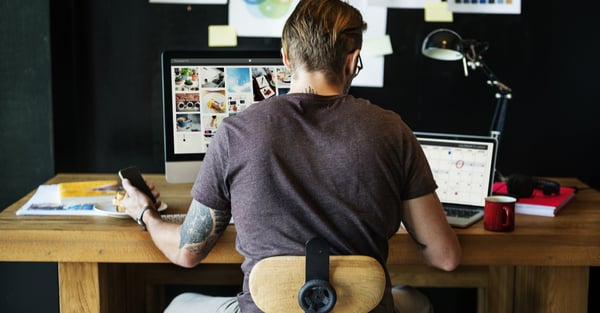With some countries around the world getting ready or have already removed the lock on lockdowns, the biggest question nowadays is how to go out into the post-coronavirus world and best adapt to new norms.
Because you have to admit, the world is reopening not because it's already safe but because the economy and the people need to survive.
The threat of coronavirus remains. This makes preparing for life after coronavirus a challenge that requires out-of-the-box solutions.
There are so many new factors at play, with social and physical distancing having the most impact.
John Hopkins defines it as putting a distance of at least six feet between you and someone else. To put that into perspective, it's the same width as that of a standard three-seater sofa and the same height of an average door.
Imagine. Just imagine what this means when working in a small office, when taking a bus or train, when queuing at the cashier, or when watching a football game.
If you're at the gym or exercising in public places, you'll need to stretch that distance further. In fact, runners are advised to stay fifteen feet apart from each other because of how the air moves under such conditions.
The long and short of it, say goodbye (at least for the foreseeable future) to any ways or forms of physical contact and to free hugs that used to make people's day.
Such is the new normal post-COVID-19. Do we wail or sail past the consequences and knock-on effects of the pandemic?
Checklist: What TO DO and NOT TO DO when the lockdown ends
Different agencies, such as the CDC and the WHO, have released reopening guidelines designed to prepare and reduce the risks of coronavirus exposure in businesses, homes, public spaces, schools, and workplaces.
The fact that a guideline is necessary at all is proof that nothing is the same. There are public health and cleaning and disinfecting strategies that must be observed if communities are to reopen and remain open.
So, before you go out there, it's vital that you're aware of the best practices of rejoining the world the safest way possible.

Practise cautious optimism
In addition to being vigilant in observing rules to keep you and everyone else safe, it's important to remain cautiously optimistic.
With the lockdowns lifted, you've regained your freedom to go out and about and restart your life. But because your safety is not 100% guaranteed, be realistic about what the new freedom is like.
Don't relax your guard
A crowd of people at the beach who came home without showing symptoms within the incubation period doesn't mean they're safe, or that it's perfectly okay for you to do the same thing.
You'll never know when the next asymptomatic patient will come within close range of you and put your life at risk. Remember that you're facing an invisible enemy and becoming too comfortable because the world is reopening and people are coming out can be your undoing.
Refresh your memory about COVID-19 and what you can do to protect yourself and others.
At home
What are your thoughts about going out after a month-long quarantine? Do you feel safer within the confines of your home and less outside of it? Or, are you just raring to go out and see something else other than the walls of your home?
Different people have different feelings and mixed reactions to communities reopening. Because there are no guidelines in your home, you might want to make one.
Give your mental well-being a thorough inspection.
The impact of COVID-19 may seem less jarring than a disaster or war, but trauma can still happen. Many of us are exhausted mentally and physically because of the pandemic's knock-on effects--job loss, depleted savings, or fear of health and safety.
Set up rules/measures on what to do before and after you go out.
How do you plan to minimise exposure when you step out of the house? How can you disinfect yourself when you come home or whatever else you need to bring into the house to protect your loved ones? So many things to think about and prepare for.
Work out your transportation needs.
Heavy traffic used to be one major problem when commuting but not anymore. Now, you need to be extra careful of where to sit, when to travel, or what to touch.
Some countries have rolled out guidelines on how to remain safe on trains and buses, which you should take into account. Singapore, for example, implores commuters not to travel during peak hours if possible. What has your government done to ensure commuter safety? And have you been doing your part by observing such guidelines?
When working from home

The new workplace arrangement may include a distributed workforce or with 50% of the employee population working from home. If you're one of the WFHers, you need to work on self-care, which might be new to someone who's worked at an office most of their life.
- Find ways to stay healthy, boost your mood, and prevent cabin fever. Start with paying close attention to your health and making lifestyle changes to boost your mind, body, and mood.
- Figure out how to focus and remain productive throughout the workday. Create a schedule and stick with it. Set up your own home office that is free from distractions and temptations.
- Develop practices for effective communication with co-workers. You want to stay connected without wasting time on useless information. Use communication tools and software at your disposal. Make a list of people to contact when you hit a wall.
- Be a master of your daily routine, especially when dealing with project deadlines. Do you prefer to work on the bigger tasks first or vice versa? Are you more productive with bigger tasks broken down into smaller ones? Find the daily routine that works for you, so you can submit projects on time.
- Make a list of habits/routines you miss and don't miss. Find ways to enjoy or reimplement at home routines you miss and let go of those you don't miss at all. Be mindful of when you start doing things that will cause you to revert to old patterns and habits best forgotten.
The same strategies listed above are recommended for people who have been working from home but have yet to master productivity and efficiency.
Prepare for the long term
When restriction ease, expect possible spikes of infected cases that might elevate your fears of going out of the house and to work. It's prudent that you continue to take personal safety measures seriously and to prepare mentally for when the situation might worsen.
Find out what your company is offering in terms of work arrangements or return-to-workplace options. Twitter, for example, has extended remote work and allows employees to work at home forever. Facebook, on the other hand, will allow remote work until the end of 2020. You might be allowed flexible work schedules or to work at reduced hours and still get paid full-time.
Lastly, invest in yourself and your pocket. Boost your professional skills and resources so you can continue to work remotely and to switch careers when needed due to another crisis. Invest in safe financial vehicles now while you can still buy low and add another income stream. You might want to double your retirement contributions, too.
When doing business

Businesses have it hard when it comes to preparing for life after coronavirus. Some of them might not even be fully operational, depending on the nature of their business.
Others need to rethink their policies to deliver the same services without risking the lives of their employees and their clients. Some might have to limit their reach domestically until such time globalisation becomes viable again.
Are you planning to reopen your business soon?
The first thing you need to do is to check if there are general or sector-specific guidelines that your government has set to ensure a safe workplace and business. Singapore, for example, has released an advisory on how certain businesses can resume activities gradually.
Then, it's up to you to create a reopening process that is manageable and navigable by everyone involved.
Prepare to reopen with as little downtime and confusion as possible
Before you open your doors, make sure you already have safety measures in place supported by the appropriate guidelines and policies.
- Set rules for social distancing, cleaning and disinfecting business premises, travelling to and from work and to other locations, on-site visits, etc.
- Develop policies for health monitoring and solutions for when an employee shows symptoms of COVID-19.
- Develop guidelines for contract tracing when a member of the workforce tests positive for coronavirus.
- Decide how employees will work--teleworking, reduced work hours or days, special accommodation for high-risk employees, etc.
- Take a moment to sit down and list down different aspects of your business that must change to maintain social distancing and to keep everyone safe.
Pay close attention to state and community guidelines
Is your business approved to reopen? Do you need to remove close common areas before you're approved to reopen for business? Are employees returning to work gradually or in full?
Different states have different rules. It's best to verify any state and local guidelines you need to adhere to.
Check your current financial health and plan accordingly
Some companies may have scored big during the lockdown but others could only watch helplessly as their businesses collapsed and flatlined.
Which side of the fence are you?
Either way, give your finances a thorough inspection. Gather data and numbers that will give you a clear perspective on how your capital, cash flow, and revenue are doing.
- Check if you’re eligible for future appropriations or cash assistance and find ways to leverage this.
- Look for alternative funding sources and take advantage of them.
- Develop a cash flow plan that takes into account the estimated cost of the new normal and reopening strategies.
Review old processes and set new ones with a goal to reduce costs
Re-evaluate operations and processes to:
- Identify what can be kept, revised, or removed
- Adjust where needed to accommodate the new normal
- Find efficient ways to trim costs while maintaining quality products and services
- Find the most effective ways to bring in more money despite new changes set to be implemented
- Develop strategies to maintain a stronger position even if another recession hits
- Put your money on safe investment options
Evaluate supply chains and create appropriate solutions
The resiliency of your supply chain can help your company at a time and in an environment of high uncertainty. Post-coronavirus, you’ll need supply partners that will support your business' structural transformations and altered processes.
Give automation a go
When your revenue has yet to recover, paying for a human workforce can be expensive. So you might want to look into how you can integrate automation and digitalisation into your business.
This is also one way to reduce the risk of your employees being exposed to coronavirus that could set you back even further since you might need to shoulder healthcare needs.
Adapt to digitalisation
Coronavirus has forced many businesses to embrace digital transformations and, in some cases, forced them to move their operations virtually.
Remote learning became the norm during the lockdown and many realised its importance to students, especially schools in developing countries where technology has yet to be at the forefront in the delivery of education.
Web conferences and virtual events replaced in-person and face-to-face interactions, which gave rise to tech tools and software for collaboration and communication.
How digital is your business now?
Work out how to reintegrate your workforce minus the health and safety risks
When working from home is not possible, you need to plan out how your employees can resume in-office work post-lockdown. The goal is to ensure they come to work and remain safe day in and day out.
- How many people do you need to prepare your business for a full reopening?
- Do you need everyone to come to the office or just a few people with specific skill sets?
- Do you have a plan for when furloughed staff and those who continued working from home come together in the same room and are unhappy with the situation?
- Are there processes that have been put on hold that need to be restarted or put off forever?
- What do you have in place to address the need for disinfection, social distancing, health monitoring, and reduced exposure to coronavirus?
- Identify your portfolio’s problems
Work out how to send your staff to people’s home without risking their lives
Plumbers, carpet cleaners, electricians, and other service staff are at risk of infection because they visit places where people might be infected.
What measures are you taking to ensure they don't get infected or infect others? Are they equipped with the appropriate personal protective equipment (PPE)? What guidelines must they follow when visiting high-risk areas?
Rebuild and reinforce customer relationships and experiences
Whether you've kept in contact with your customers during the lockdown, make sure to reconnect with them across multiple channels. Using data-driven insights, find out how you can become an indispensable part of their lives.
What if your business is categorised as likely to remain closed/partially operational post-coronavirus?
COVID-19 has closed certain businesses indefinitely. These include gyms, theatres, hairdressers, and pubs and cafes.
The best approach is to adjust your business to address the worries of wary customers. Who would want to go to a crowded gym or restaurants when risk exposure remains high?
This is the time to advertise more spacious seating, a limited number of people per hour or day, streaming or virtual alternatives where possible, or highly improved disinfection tools and processes.
Prepare for the long term
The first few weeks or months will be a test for everyone. You need to prepare for any possibility during the transition and beyond.
- How can you ensure employee morale, momentum, motivation remain high?
- Do you plan to monitor and control employee health and for how long? Some might not be open for testing. You might not have the ability to pay to continually monitor staff.
- What do you have planned for when staff are no longer open to temporary pay cuts or postponed compensation and benefits to keep the business running?
- How much of your business can be permanently moved online? How will you carry out this shift without major disruption to your operations?
- Find the answer and you can develop sound solutions.
Focusing on the financial front

Reassess financial management strategies
How did your finances fare during the lockdown? Whether good or bad, you should re-evaluate your strategies for managing your funds post-coronavirus.
- Get a grip on the numbers and data for a clearer view of debts, profit, and expenses, all of which can affect your bottom line.
- Adjust your financial plan. You might want to shore up on savings from the frugality and downsizing the coronavirus has enforced. Build or boost passive income. Find ways to make your finances recession-proof.
- Optimise your portfolio. Make sure you're investing safely and wisely. Put your money on stocks that will weather the storm in the markets. Keep an eye on companies that will survive a recession.
- Generate cash and protect liquidity. For your business to survive the uncertainty of the times, identify longer-term cash resources such as areas where costs can be reduced/optimised and alternative sources of revenue.
- Preserve working capital. One option is to delay payments to suppliers without destroying business relationships. Another is to offer customers discounts if they pay sooner than later.
- Manage creditors and debts. Be proactive and transparent in communicating with lenders regarding cash flow and recovery situations. You might be able to negotiate better terms with them.
- Inverse ETFs: Earn profit while the rest of the market suffers
Develop short-term or daily habits that will bring in income
- Leverage online sales and marketing tools that will earn you extra income. PipBox, for example, is an online passive income platform that lets you earn on autopilot just by sharing content on social media. You won't even need to write the content yourself.
- Cut daily expenses, control discretionary spending, and take advantage of small savings you can earn from various sources. The app Honey, for instance, gives you access to the best discount codes online. PayMaya and Shopback, on the other hand, lets you earn back a percentage of the money you spent on online shopping.
- Save up as much as possible. Since you've cut down your spending, any extra funds you have should go to your savings or emergency fund. You need to beef this up in case a second or third wave happens. You'll never know.
- Find options for a passive income. It's one of the best ways to make more money and recession-proof your finances.
Get rid of redundant spending. Do you really need both Netflix and cable TV?
Prepare for the long term
Build multiple revenue streams that can sustain you in the long haul
- Start a blog or dabble into affiliate marketing or a referral program
- Invest for the long term and for smart returns
- Participate in paid surveys
- Get into the freelance gig and put your skills to work
- Start a home-based business, preferably one that is highly in-demand during this crisis
- Buy and sell online
Sharpen your financial literacy
The better you understand the market the easier it will be to effectively manage your finances and ensure your portfolio earns you money regardless of the market conditions.
Some of the most trusted resources to visit are:
What’s your new reality?
The world post-lockdown was not something anyone was prepared for before the pandemic broke out. The year 2020 started out just fine but has drastically changed since.
As many countries gradually roll out exit strategies, people must learn how to survive the post-coronavirus world and beyond.
According to Dr Mike Ryan who heads the Health Emergencies Programme of the World Health Organization, epidemics often come in waves and a second peak of the coronavirus should be expected.
Time to prepare for this too as you gradually reintegrate into society.
Here's one alternative to protect your finances and grow your wealth post-lockdown or during the second wave. Trade in the world's largest financial market. No better place to start than right here with us! Begin trading with Fullerton Markets today by opening an account:
You might be interested in: You Should Invest during the COVID-19 Downturn! Here's How to Navigate the Market Safely and Profitably














